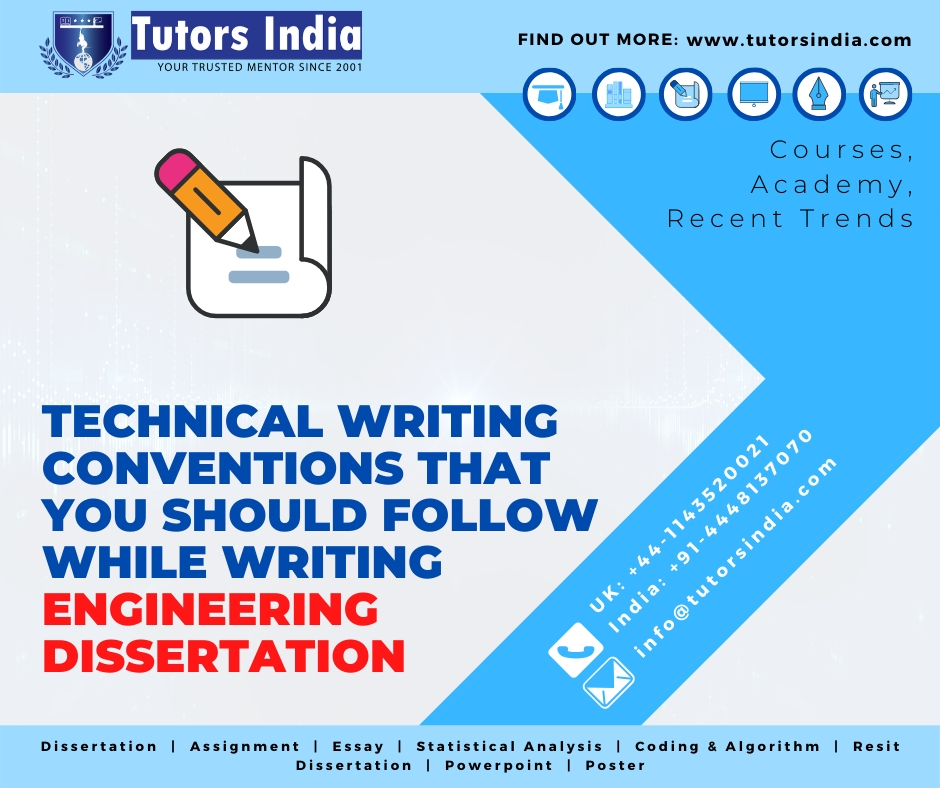Technical Writing Conventions That You Should Follow While Writing Engineering Dissertation
In Brief (Highlights)
- You will find the best dissertation research areas/topics for future researchers enrolled in Engineering and Technology.
- In order to identify future research topics, we have reviewed the technical conventions. (recent peer-reviewed studies).
- Technical writing is far much different from the other casual forms of writing such as essays, poetry etc
- There are some specific guidelines or conventions to be followed while writing a technical document.
- There are different types of technical documents such as reports, white paper, dissertation etc.
- It is necessary that the content incorporated in technical documents in precise, in accordance with the format and accurate.

Background
Technical writingdiffers from the other forms such as advertising, essay writing , poetry etc in different aspects such as language style, formatting etc. The technical writing is associated with process, system and contrary to the non-technical documents it emphasizes on accuracy rather than style. Thus it becomes necessary that in order to develop a good technical writing the content should be accurate, concise, clear, well-planned. In addition the spellings, grammatical errors should also be considered significant while preparing the document (Ali & Al-Othmany, 2012).
To summarize it can be asserted that technical writing emphasizes on the accuracy of matter and the language used (grammatically correct). Apart from the aforementioned constructs, the technical writing also adheres to specific rules and conventions (McMillan & Weyers, 2010). Also, avail dissertation research proposal, dissertation topic selection, research planning serviceand more for any research project.
You will find the best Technical writing for future researchers enrolled in Engineering and Technology. These topics are researched in-depth at the University of Glasgow, UK, Sun Yat-sen University, University of St Andrews and many more.
There are different approaches that are followed while writing technical documents such as dissertations,
Download our internationalization technical writing related Reference book papers such as tutorials, proprietary materials, research projects and many more @ tutorsindia.com/academy/books
Tutors India has vast experience in writing technical content for engineering students pursuing in UK. Order Now
In Writing for Science and Engineering: research article, Reports and presentation, the researcher (Silyn-Roberts, 2012) defines a layout by the shortening AIMRAD that views for:
- Abstract
- Introduction
- Methods & materials
- Results
- Discussion
A snippet of the conventions to be followed while writing these sections of the technical document is given as follows:
- Abstract: writing an abstract is the most important element that gives an insight of . It gives an idea about the approach followed in research. Though the length of abstract varies for different documents, in should not have more than 300 words.
- Introduction: should exhibit with the topic and future scope of the document. It is that part of the document that is planned as per the audience. This section gives a brief idea about the different works performed by others. To summarize, this section comprises background, objectives, problem formulation and research outline.
- Literature review: In this section of the document a brief description of the previous works and the present advancements associated with the document is mentioned.
- Methods & Materials: This section includes the procedure and materials that are employed conducting the research. It discusses the experimental design of the research.
- Results & discussion: This part of the document comprises experimental data, and discusses the observations of the author. It presents the data formatted in different forms such as tables, graphical illustrations, charts etc.
- Conclusion & Recommendations: This is the most vital section of as it gives an explanation of obtained should be considered as valid. Thus to give a clear understanding of the research to the audience the content presented in this section should be precise and accurate. Considering the conclusion author can provide some useful recommendations and enable the author as well as audience to decide that how can the approach discussed be implemented and whether it will be feasible or not.
In order to identify the sources for technical writing, we have reviewed the technical document (recent peer-reviewed topics) on Engineering.
Special Features of Technical Writing
Apart from the afore-mentioned elements of a technical document, there are also some other features that should be incorporated. Some of these features are:
- Use of Tables and Graphics: Tables, diagrams, graphs, charts are some of the key elements that are likely to be found in an engineering dissertation. These illustrative forms of presenting the content enable the author to present the content effectively as well to have proper understanding of the content. In forms also give a professional look to the document and facilitate a clear comparison in the change of . However, in order to include this feature in the writers should have knowledge about the conventions to be followed. These conventions provides information about labeling, numbering necessary conditions for incorporating graphics into text.
- Graphics in Instructions: While preparing a technical document it is sometimes not possible to convey through words. In this case graphics serve the need. They convey the information as desired by the author.
- Plagiarism: This the most important feature of any document. can be defined as the use of other’s work, them as their own work and not providing any sources or reference to it. This might seem easier to this issue needs to be rectified and hence the content should be plagiarism free.
- Reference: There are generally three most common styles of in the engineering dissertation. They are as follows:
1. Parenthetical short text references linked to a list of references
- Modern Language Association (MLA) style
- American Psychological Association (APA) style
2. In-text numbers linked to a list of references
- Council of Biology Editors (CBE) citation-sequence system
- Institute of Electrical and Electronics Engineers (IEEE) reference style
3. In-
- Abbreviations: The abbreviations mentioned in any technical document for the first time should be spelled out fully.
- Numbers: There is a wide use of numbers in an engineering document. However, to avoid confusion there have been mentioned some guidelines by Beer & McMurrey (2005).
- Equations: Equations should be incorporated in any technical document as they convey the ideas more effectively than words (Fezari & Al Dahoud, 2018).
Summary
From the above discussion it can be concluded that adhering
to certain guidelines while writing an engineering dissertation avoids
confusion and fulfils the objective of delivering a concise and accurate
report. The conventions are helpful in organizing a well-planned report.
Keeping these conventions in mind one can plan organization of thesis properly.
References
- Ali, M. S., & Al-Othmany, D. (2012). How To Be An Effective Technical Writer? International Journal Of Engineering Pedagogy (IJEP), 2(3), 4. Https://Doi.Org/10.3991/Ijep.V2i3.2094
- Beer, D. F., & Mcmurrey, D. A. (2005). A Guide To Writing As An Engineer. Wiley. Https://Books.Google.Co.In/Books?Id=Ul8eaqaaiaaj
- Fezari, M., & Al Dahoud, A. (2018). Guide And Hints To Write Engineering Research Paper. Https://Www.Researchgate.Net/Publication/327831767_Guide_And_Hints_To_Write_Engineering_Research_Paper
- Mcmillan, K., & Weyers, J. D. B. (2010). How To Write Dissertations & Project Reports. Prentice Hall. Https://Books.Google.Co.In/Books?Id=X_5jpgaacaaj
- Silyn-Roberts, H. (2012). Writing For Science And Engineering: Papers, Presentations And Reports. Newnes. Https://Books.Google.Com/Books?Hl=En&Lr=&Id=Gy64f4w8kumc&Oi=Fnd&Pg=PP1&Dq=++Heather+Silyn-Roberts,Writing+For+Science+And+Engineering:+Papers,+Presentations,+And+Reports.+Oxford:+Butterworthheinemann,+2000.&Ots=Eaqed-Sl_5&Sig=Bfgscxyvfzb8iykt6bx95swhlro

 Previous Post
Previous Post Next Post
Next Post